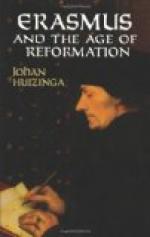A grave question arose whether the new races discovered in the West were to be accounted as saved or damned. Ellenbog quotes Faber Stapulensis’ statement that nothing could be more bestial than the condition of the Indians whom da Gama had discovered in 1498 in Calicut, Cannanore, and Ceylon; it was to be feared that the Indians of the West were no better. In writing to Ellenbog six months later to say that he had no clear opinions on the question, Eck uses an interesting expression: ’To ask what I think is like looking for Arthur and his Britons.’[16] The reference is to the Arthurian legend and the long-expected, never-fulfilled, return of the great king; but the humanists usually leave the whole field of mediaeval romance severely alone.
[16] Arcturum cum Britannis
exspectatis. For another allusion
to
Arthur, see Pace, De Fructu, p. 83.
One September morning, when the dew was still heavy, Ellenbog went out with some brethren to gather apples. At the top of the orchard[17] one of them called out that he had found ‘a star’. It was a damp white deposit on the grass, clammy and quivering, cold to the touch, very sticky, with long tenacious filaments. Ellenbog had never seen anything like it, but he found out that the peasants and the shepherds believed such things to be droppings from shooting stars,[18] if not actually fallen stars, and that they were thought to be a cure for cancer. His letter describing it is to ask the opinion of a friend who was a doctor, that is to say, the scientist of the age.
[17] ortus.
[18] stellae emuncturam
et purgamentum.
The affairs of Ellenbog’s family often appear. His father had been a great collector of books, which he had corrected with his own hand, and which at his death he had wished to be kept together as a common heirloom for the whole family. A great many of them were medical, and therefore it had seemed good that the enjoyment of the books should go to Ulrich, the son who was studying medicine at Siena. On his way home, after completing his course, Ulrich died; and Nicholas composed a piteous appeal on behalf of the books, bewailing their fate that after ten years of confinement their hope of being used had come to nothing. Onofrius was the only brother from whom might be hoped a younger generation of Ellenbogs, one of whom might study medicine. Elizabeth’s children were Geslers, and so apparently did not count.
How long the books were kept together is not known. One of them is now in the University Library at Cambridge, and has been excellently described in an essay by the late Robert Proctor. It consists of several volumes bound together: Henry of Rimini on the Cardinal Virtues, the Journey of a penitent soul through Lent, a treatise de diuina predestinacione, and John Peckham, Archbishop of Canterbury, de oculo morali—all of a definitely religious or moral character. They are freely annotated




